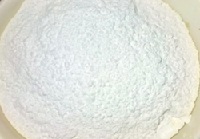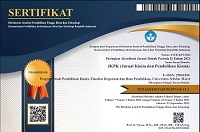
Characterization of Chicken Eggshell-Derived Hydroxyapatite/Zeolite Composite as a Methylene Blue Absorbent
Abstract
Purebred chicken eggshell is a promising natural source because it contains high calcium carbonate (CaCO3), which is used as a hydroxyapatite (HAp) precursor, with natural abundance and biodegradability, making it an eco-friendly alternative to synthetic materials. HAp is relevant for dye removal because of its high adsorption capacity, chemical stability, and ability to interact with dye molecules through ion exchange and surface interactions with the material. The composite adsorbent of Hap-zeolite is effective for wastewater treatment based on the result of HAp-zeolite composite's adsorption capacity against methylene blue. Methylene blue is one of the dyeing wastes originating from the textile industry. The method of synthesis of Hap used precipitation. The FTIR characterization results showed OH groups at wavenumber 3434 cm-1, CO32- group with wavenumber 1421 cm-1, PO43- bending group with wavenumber 565 cm-1, and PO43- stretching at wavenumber 1035 cm-1. The highest peak XRD yield at an angle of 2θ=34.04º corresponds to a hexagonal crystal formed. The adsorption process is carried out with a HAp-zeolite mass ratio of 4:2 (w/w), with contact times for 180 minutes, resulting in the best adsorption efficiency around 99.99% measured via UV-Vis spectrophotometry. The results indicate that HAp-zeolite composites are highly effective for methylene blue removal and have potential application in wastewater treatment.
Keywords
Full Text:
PDFReferences
Nurliani, I. Rosada, S. Nurani Sirajuddin, A. Razzaq Al Tawaha, A. Rahman Mohammad Said Al-Tawaha, and A. Karnwal, “Factors Affecting the Trend in the Number of Chicken Eggs Produced in South Sulawesi,” REDVET-Revista electronica de Veterinaria, vol. 25, no. 1, pp. 108–119, 2024, [Online]. Available: http://www.veterinaria.orghttp://www.veterinaria.org [2] V. Sisca and J. Rahayunigsih, “Pembuatan Limbah Cangkang Telur Sebagai Katalis Heterogen untuk produksi Biodisel,” Journal of Research and Education Chemistry, vol. 4, no. 2, p. 134, Dec. 2022, doi: 10.25299/jrec.2022.vol4(2).10862. [3] H. Setiawan, U. F. Anindi, D. Y. Pulungan, N. Akbar, A. R. Noviyanti, and Solihuddin, “Biocomposite of Hydroxyapatite from Chicken Egg Shells and Biochar from Rice Husk an an adsorbent for Copper ion and methylene Blue,” Jurnal Keramik dan Gelas Indonesia, vol. 29, no. 1, pp. 1–14, 2020. [4] N. Jamarun, N. A. Trycahyani, S. Arief, U. Septiani, and V. Sisca, “Synthesis of Hydroxyapatite-Polyethylene Glycol with In-Situ Method Using Calcium Oxide from Blood Shells (Anadara granosa),” Indonesian Journal of Chemistry, vol. 23, no. 3, pp. 618–626, Jun. 2023, doi: 10.22146/ijc.78538. [5] A. O. Vironika, L. R. Jurusan, F. Fakultas, M. Ilmu, and D. Pengetahuan, “Sintesis CaCO3 dari Dolomit Bangkalan dengan Metode Leaching Synthesis of CaCO3 from Bangkalan Dolomite by Leaching Method,” vol. 7, no. 1, pp. 39–42, 2022. [6] A. D. Wuntu, D. M. H. Mantiri, J. J. H. Paulus, and H. F. Aritonang, “Hydroxyapatite/zeolite-based antibacterial composite derived from Katsuwonus pelamis bones and synthetic A-type zeolite,” AACL Bioflux, vol. 14, no. 1, pp. 612–619, 2021, [Online]. Available: http://www.bioflux.com.ro/aacl [7] Firnanelty, A. Nur Fitriani Abubakar, A. Qurniawan, and M. A. Syam, “COMPARISON OF AIR CONTACT AND DISTILLED WATER DISTRIBUTION METHOD IN THE CONVERSION OF Cao TO Ca(OH)2 AS A PRECURSOR HYDROXYAPATIT,” JKPK (Jurnal Kimia dan Pendidikan Kimia), vol. 8, no. 3, pp. 423–434, 2023, doi: 10.20961/jkpk.v8i3.78348. [8] N. H. Z. Abidin, N. S. Sambudi, and N. A. Kamal, “Composite of hydroxyapatite-fe3o4 for the adsorption of methylene blue,” ASEAN Journal of Chemical Engineering, vol. 20, no. 2, pp. 140–153, 2020, doi: 10.22146/ajche.55015. [9] J. Gago and Y. Dala Ngapa, “PEMANFATAAN CANGKANG TELUR AYAM SEBAGAI MATERIAL DASAR DALAM SINTESIS HIDROKSIAPATIT DENGAN METODE PRESIPITASI BASAH,” 2021. [10] Firnanelty, S. Sugiarti, and Charlena, “Synthesis of HAp-chitosan-PVA composite as injectable bone substitute material,” Rasayan Journal of Chemistry, vol. 10, no. 2, pp. 570–576, 2017, doi: 10.7324/RJC.2017.1021465. [11] T. O. Pangestu, S. F. Damayanti, S. S. Santi, and S. Muljani, “Sintesis dan Karakterisasi Kalsium Fosfat dari Cangkang Bekicot dengan Metode Presipitasi,” CHEESA: Chemical Engineering Research Articles, vol. 4, no. 2, p. 82, Aug. 2021, doi: 10.25273/cheesa.v4i2.8931.82-90. [12] A. D. Wuntu, D. M. H. Mantiri, J. J. H. Paulus, and H. F. Aritonang, “Hydroxyapatite/zeolite-based antibacterial composite derived from Katsuwonus pelamis bones and synthetic A-type zeolite,” 2021. [Online]. Available: http://www.bioflux.com.ro/aacl [13] D. F. Fitriyana et al., “The effect of hydroxyapatite concentration on the mechanical properties and degradation rate of biocomposite for biomedical applications,” in IOP Conference Series: Earth and Environmental Science, IOP Publishing Ltd, Feb. 2022. doi: 10.1088/1755-1315/969/1/012045. [14] J. Abidin and F. A. Hasibuan, “Pengaruh dampak pencemaran udara terhadap kesehatan untuk menambah pemahaman masyarakat awam tentang bahaya dari polusi udara,” Prosiding Seminar Nasional Fisika Universitas Riau IV, no. September, pp. 978–979, 2019. [15] M. N. A. S. Pu’ad, J. Alipal, H. Z. Abdullah, M. I. Idris, and T. C. Lee, “Synthesis of eggshell derived hydroxyapatite via chemical precipitation and calcination method,” in Materials Today: Proceedings, Elsevier Ltd, 2019, pp. 172–177. doi: 10.1016/j.matpr.2020.11.276. [16] I. A. Suci and Y. Dala Ngapa, “SINTESIS DAN KARAKTERISASI HIDROKSIAPATIT (HAp) DARI CANGKANG KERANG ALE-ALE MENGGUNAKAN METODE PRESIPITASI DOUBLE STIRRING,” 2020. [17] L. Trivana, S. Sugiarti, and Rohaeti, “SYNTHESIS OF ZEOLITE AND COMPOSITE OF ZEOLITE/TiO2 FROM KAOLIN AND ITS APLICATION TO ADSORPTION-PHOTODEGRADATION OF METHILEN BLUE,” ALCHEMY jurnal penelitian kimia, vol. 11, no. 2, pp. 147–162, 2015. [18] F. Khorasani, M. Khavarpur, and M. S. Lamuki, “Synthesis of Hydroxyapatite / Zeolite Nanocomposite for Medical and Dentistry Applications,” Science Arena Publication Specialty Journal of Chemistry, vol. 4, no. 1, pp. 9–19, 2019, [Online]. Available: www.sciarena.com [19] C. Y. Tahya, W. Irawati, Karnelasatri, and F. J. Purba, “Synthesis and characterization of TiO2-CaO and TiO2-CaO-Fe2O3 photocatalyst for removal of catechol,” Molekul, vol. 14, no. 2, pp. 140–148, Nov. 2019, doi: 10.20884/1.jm.2019.14.2.570. [20] F. Fadliah, C. Palit, R. Pratiwi, R. Aryanto, and T. W. Putri, “Analysis the Effect of Activated Natural Zeolites for Fe Metal Adsorption,” Walisongo Journal of Chemistry, vol. 6, no. 2, pp. 143–148, Dec. 2023, doi: 10.21580/wjc.v6i2.17291. [21] Y. D. Ngapa, S. Sugiarti, and Z. Abidin, “Hydrothermal Transformation of Natural Zeolite from Ende-NTT and Its Application as Adsorbent of Cationic Dye,” 2016.
Refbacks
- There are currently no refbacks.








